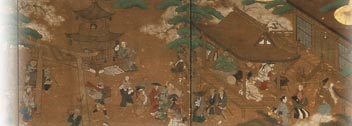Welcoming Alexei Ratmansky, artistic director of the Bolshoi Ballet: Special lecture on “The Bright Stream”
Outline
| date | On December 2, 2009 |
|---|---|
| Venue | Waseda University (Okuma Memorial Tower) |
| Organizer | Dance Studies Course |
| outline | Welcoming Alexei Ratmansky, artistic director of the Bolshoi Ballet: Special lecture on “The Bright Stream” |
Details
On December 2, 2009, the Dance Studies Course held a lecture entitled “On The Bright Stream”, to which it invited Alexei Ratmansky, the Bolshoi Ballet’s artistic director. Between November 22 and December 14, the Russian State Bolshoi Ballet Company was giving performances throughout Japan from Kyushu to Hokkaido; in the middle of this hard schedule, Mr. Ratmansky kindly came to the lecture hall immediately upon his arrival from Hokkaido on the evening before performances were to begin in Tokyo. This lecture was made possible through the cooperation of Japan Arts. SATO Hiroko (lecturer, Hosei University) served as interpreter.Mr. Ratmansky was born in Leningrad (now St. Petersburg) in 1968; he studied at the Bolshoi Ballet School in Moscow, and after performing with the Kiev Ballet and the Royal Winnipeg Ballet (Canada), he became a soloist with the Royal Danish Ballet in 1997 and a principal in 2000. Around that time he began to attract worldwide attention as a choreographer, and in 2004 he assumed the position of artistic director of the Bolshoi Ballet.
The lecture was in the form of answers to questions raised by SUZUKI Sho (GCOE guest lecturer); in the first half Mr. Ratmansky talked about his background and his work so far. For us in Japan the image of Mr. Ratmansky as a star of the Kiev Ballet from a 1989 broadcast on NHK is so strong that it was striking to hear him say with some embarrassment, “I graduated from the Bolshoi Ballet School but wasn’t good enough to join the Bolshoi Ballet.” He tried his hand at choreography while still in school, he said. It was extremely interesting to hear him strongly criticize the old-fashioned mindset of the Russian ballet world, which does not give young dancers the opportunity to do choreography.
This time the Bolshoi Ballet brought three works to Japan, “Swan Lake”, “Don Quixote”, and “The Bright Stream”. The first two are meant for general ballet fans or for beginners; what attracted the attention of serious ballet aficionados and researchers was “The Bright Stream”. The second half of the lecture focused on this work.
Shostakovich’s “The Bright Stream” premiered in 1935 with choreography by Fyodor Lopukhov and was well received. The following year, however, it was criticized in Pravda, the official newspaper of the Soviet Union’s Communist Party Central Committee, and dropped out of the repertoire; Lopukhov was forced to resign as artistic director. Sixty-eight years later in 2003, a version using the original music and libretto but with completely new choreography by Mr. Ratmansky premiered at the new Bolshoi Theatre.
“The Bright Stream” is the name of a fictional kolkhoz (collective farm) in the northern Caucasus. When a travelling troupe of artists from Moscow comes to the farm at harvest time, a slapstick comedy ensues. The center of the plot is a silly story about a wife who punishes her husband’s infidelity, reminiscent of Mozart’s “Marriage of Figaro” or Strauss’s “Der Fledermaus (The Bat)”.
Mr. Ratmansky said that he proposed the revival of this work himself. He stressed that it is a work that connects the past to the present. Its uniqueness lies in its elimination of the abstractness found in a large number of modern works; it contains many mime-like movements. Although these movements are completely different from mime in classical ballet, they preserve the specificity of the movement being mimed. In the lecture Mr. Ratmansky emphasized the importance of mime and was implicitly critical of the style of Yuri Grigorovich, who eliminates mime altogether. As for Mr. Ratmansky’s own choreography, he mainly uses danse classique but adds a twisting and dislocation here and there. That is the reason his choreography is regarded as neoclassical. Humor and an affirmation of life can probably also be cited as characteristic of Mr. Ratmansky’s work. In fact, “The Bright Stream” is an unusual ballet in that the audience can often be heard to laugh out loud.
Mr. Ratmansky stressed that music is of prime importance in ballet. He is especially interested in 20th-century Russian music, and when the conversation turned to Prokofiev and Shostakovich he spoke quite passionately, giving the impression that he would never have enough to say about them.
After the Japanese tour, Mr. Ratmansky left the Bolshoi Ballet and assumed the position of artist-in-residence at the American Ballet Theater. A new work of his has already been announced for their Met season in June. The American media have heralded his arrival as the second coming of Balanchine, and, in fact, in a period noted for a dearth of choreographers, there is no doubt that he is the possessor of a rare talent and is likely to be active for a long time to come.


